Sustainable Coexistence: Wind Energy Development and Beekeeping Prosperity—A Propensity Score Matching Approach
Abstract
1. Introduction
2. Data and Methods
2.1. Data
2.2. Method
2.3. Justifications for Using Explanatory Variables
3. Results
3.1. Descriptive Statistics and Group Mean Comparisons
3.2. Some Sensitivity and Robustness Checks
3.3. Propensity Score Matching Results
4. Discussion
5. Conclusions
Author Contributions
Funding
Institutional Review Board Statement
Data Availability Statement
Acknowledgments
Conflicts of Interest
References
- Bouzarovski, S.; Petrova, S. A global perspective on domestic energy deprivation: Overcoming the energy poverty–fuel poverty binary. Energy Res. Soc. Sci. 2015, 10, 31–40. [Google Scholar] [CrossRef]
- Mboumboue, E.; Njomo, D. Potential contribution of renewables to the improvement of living conditions of poor rural households in developing countries: Cameroon’s case study. Renew. Sustain. Energy Rev. 2016, 61, 266–279. [Google Scholar] [CrossRef]
- Armeanu, D.Ş.; Vintilă, G.; Gherghina, Ş.C. Does renewable energy drive sustainable economic growth? Multivariate panel data evidence for EU-28 countries. Energies 2017, 10, 381. [Google Scholar] [CrossRef]
- Baz, K.; Cheng, J.; Xu, D.; Abbas, K.; Ali, I.; Ali, H.; Fang, C. Asymmetric impact of fossil fuel and renewable energy consumption on economic growth: A nonlinear technique. Energy 2021, 226, 120357. [Google Scholar] [CrossRef]
- International Energy Agency. World Energy Outlook. International Energy Agency 2004. 2004. Available online: https://www.iea.org/reports/world-energy-outlook-2004 (accessed on 2 April 2025).
- Kaya, K.; Şenel, M.C.; Koç, E. Dünyada ve Türkiye’de yenilenebillr enerji kaynaklarinin değerlendirilmesi. Technol. Appl. Sci. 2018, 13, 219–234. [Google Scholar]
- Shi, H.; Dong, Z.; Xiao, N.; Huang, Q. Wind speed distributions used in wind energy assessment: A review. Front. Energy Res. 2021, 9, 769920. [Google Scholar] [CrossRef]
- Kober, T.; Schiffer, H.W.; Densing, M.; Panos, E. Global energy perspectives to 2060–WEC’s World Energy Scenarios 2019. Energy Strateg. Rev. 2020, 31, 100523. [Google Scholar] [CrossRef]
- Ritchie, H. Sector by Sector: Where Do Global Greenhouse Gas Emissions Come From? Our World in Data. 2020. Available online: https://ourworldindata.org/ghg-emissions-by-sector? (accessed on 1 April 2025).
- Farmer, J.D.; Hepburn, C.; Mealy, P.; Teytelboym, A. A third wave in the economics of climate change. Environ. Resour. Econ. 2015, 62, 329–357. [Google Scholar] [CrossRef]
- Opeyemi, B.M. Path to sustainable energy consumption: The possibility of substituting renewable energy for non-renewable energy. Energy 2021, 228, 120519. [Google Scholar] [CrossRef]
- Kandpal, D.; Dhingra, T. Migrating to reverse Auction mechanisms in wind energy sector: Status and challenges. Energy Policy 2021, 156, 112352. [Google Scholar] [CrossRef]
- International Renewable Energy Agency. Renewable Energy Benefıts Leveragıng Local Capacıty for Onshore Wınd. Available online: https://www.irena.org/publications/2017/Jul/Renewable-Energy-Statistics-2017 (accessed on 3 April 2025).
- Gupta, R.A.; Singh, B.; Jain, B.B. Wind energy conversion system using PMSG. In Proceedings of the 2015 İnternational Conference on Recent Developments in Control, Automation and Power Engineering (RDCAPE), Noida, India, 12–13 March 2015; IEEE: Piscataway, NJ, USA, 2015; pp. 199–203. [Google Scholar] [CrossRef]
- Jansen, M.; Staffell, I.; Kitzing, L.; Quoilin, S.; Wiggelinkhuizen, E.; Bulder, B.; Riepin, I.; Müsgens, F. Offshore wind competitiveness in mature markets without subsidy. Nat. Energy 2020, 5, 614–622. [Google Scholar] [CrossRef]
- Simla, T.; Stanek, W. Reducing the impact of wind farms on the electric power system by the use of energy storage. Renew. Energy. 2020, 145, 772–782. [Google Scholar] [CrossRef]
- WindEurope. Statistics and the Outlook for 2022–2026. 2022. Available online: https://windeurope.org/intelligence-platform/reports/ (accessed on 2 April 2025).
- Global Electricity Review. 2023. Available online: https://ember-climate.org/insights/research/global-electricity-review-2023/#chapter-5-electricity-source-trends-coal (accessed on 2 April 2025).
- Liu, S.Y.; Ho, Y.F. Wind energy applications for Taiwan buildings: What are the challenges and strategies for small wind energy systems exploitation? Renew. Sustain. Energy Rev. 2016, 59, 39–55. [Google Scholar] [CrossRef]
- Başkaya, Z. Bilecik İlinin Rüzgâr Enerjisi Potansiyeli ve Metristepe Rüzgâr Enerjisi Santrali. J. Acad. Soc. Sci. 2024, 57, 253–276. [Google Scholar] [CrossRef]
- Adeyeye, K.; Ijumb, N.; Colton, J. Exploring the environmental and economic impacts of wind energy: A cost-benefit perspective. Int. J. Sustain. Dev. World Ecol. 2020, 27, 718–731. [Google Scholar] [CrossRef]
- Mikulić, D.; Lovrinčević, Ž.; Keček, D. Economic effects of wind power plant deployment on the Croatian economy. Energies 2018, 11, 1881. [Google Scholar] [CrossRef]
- Chien, F.; Kamran, H.W.; Albashar, G.; Iqbal, W. Dynamic planning, conversion, and management strategy of different renewable energy sources: A sustainable solution for severe energy crises in emerging economies. Int. J. Hydrogen Energy 2021, 46, 7745–7758. [Google Scholar] [CrossRef]
- Nguyen, P.D.; Hansen, K.L.; Catcheside, P.; Hansen, C.H.; Zajamsek, B. Long-term quantification and characterisation of wind farm noise amplitude modulation. Measurement 2021, 182, 109678. [Google Scholar] [CrossRef]
- Leroux, C.; Kerbiriou, C.; Le Viol, I.; Valet, N.; Barré, K. Distance to hedgerows drives local repulsion and attraction of wind turbines on bats: Implications for spatial siting. J. Appl. Ecol. 2022, 59, 2142–2153. [Google Scholar] [CrossRef]
- Nazir, M.S.; Ali, N.; Bilal, M.; Iqbal, H.M. Potential environmental impacts of wind energy development: A global perspective. Curr. Opin. Environ. Sci. Health 2020, 13, 85–90. [Google Scholar] [CrossRef]
- Gürbüz, E.Y.; Altıntaş, A.; Sürücü, B.; Tuncer, A.D. Rüzgar türbinlerinin yaban hayatına etkilerinin incelenmesi. Politek. Derg. 2021, 1-1. [Google Scholar] [CrossRef]
- Guest, E.E.; Stamps, B.F.; Durish, N.D.; Hale, A.M.; Hein, C.D.; Morton, B.P.; Weaver, S.P.; Fritts, S.R. An updated review of hypotheses regarding bat attraction to wind turbines. Animals 2022, 12, 343. [Google Scholar] [CrossRef]
- APIS UK. Bees and Wind Turbines. Beekeping Sciences and News, 24 September 2013. Available online: https://www.google.com/url?sa=t&rct=j&q=&esrc=s&source=web&cd=&ved=2ahUKEwi2hOfg6_WOAxVJBdsEHbDqK3YQFnoECBgQAQ&url=https%3A%2F%2Fdocuments.dps.ny.gov%2Fpublic%2FCommon%2FViewDoc.aspx%3FDocRefId%3D%257BCBD84C23-9BDF-42D0-8ADD-C442F47D8173%257D&usg=AOvVaw3zD33kJCIWpzUJbibLbv7W&opi=89978449 (accessed on 2 April 2025).
- Baytekin, H. Arı ve Rüzgâr. 2020. Available online: https://www.tarim.com.tr/Ara.aspx?ara=Ar%c4%b1%20ve%20r%c3%bczgar (accessed on 7 April 2025).
- Hennessy, G.; Harris, C.; Eaton, C.; Wright, P.; Jackson, E.; Goulson, D.; Ratnieks, F.F. Gone with the wind: Effects of wind on honey bee visit rate and foraging behaviour. Anim. Behav. 2020, 161, 23–31. [Google Scholar] [CrossRef]
- Voigt, C.C. Insect fatalities at wind turbines as biodiversity sinks. Conserv. Sci. Pract. 2021, 3, e366. [Google Scholar] [CrossRef]
- Fourrier, J.; Fontaine, O.; Peter, M.; Vallon, J.; Allier, F.; Basso, B.; Decourtye, A. Is it safe for honey bee colonies to locate apiaries near wind turbines? Entomol. Gen. 2023, 43, 799–809. [Google Scholar] [CrossRef]
- Pustkowiak, S.; Banaszak-Cibicka, W.; Mielczarek, Ł.E.; Tryjanowski, P.; Skórka, P. The association of windmills with conservation of pollinating insects and wild plants in homogeneous farmland of western Poland. Environ. Sci. Pollut. Res. 2018, 25, 6273–6284. [Google Scholar] [CrossRef] [PubMed]
- Marques, A.T.; Santos, C.D.; Hanssen, F.; Muñoz, A.R.; Onrubia, A.; Wikelski, M.; Moreira, F.; Palmeirim, J.M.; Silva, J.P. Wind turbines cause functional habitat loss for migratory soaring birds. J. Anim. Ecol. 2020, 89, 93–103. [Google Scholar] [CrossRef]
- Baidya Roy, S.; Pacala, S.W.; Walko, R.L. Can large wind farms affect local meteorology? J. Geophys. Res. Atmos. 2004, 109. [Google Scholar] [CrossRef]
- Trieb, F. Interference of Flying İnsects and Wind Parks. Study Report, Deutsches Zentrum für Luft-und Raumfahrt (DLR). 2018. Available online: https://docs.wind-watch.org/Interference-of-Flying-Insects-and-Wind-Parks.pdf (accessed on 15 January 2024).
- Danook, S.H.; Jassim, K.J.; Hussein, A.M. The impact of humidity on performance of wind turbine. Case Stud. Therm. Eng. 2019, 14, 100456. [Google Scholar] [CrossRef]
- Rosenbaum, P.R.; Rubin, D.B. Reducing bias in observational studies using subclassification on the propensity score. J. Am. Stat. Assoc. 1984, 79, 516–524. [Google Scholar] [CrossRef]
- Aakvik, A. Bounding a Matching Estimator: The Case of a Norwegian Training Program. Oxf. Bull. Econ. Stat. 2001, 63, 115. [Google Scholar] [CrossRef]
- Becker, S.O.; Caliendo, M. Sensitivity analysis for average treatment effects. Stata J. 2007, 7, 71–83. [Google Scholar] [CrossRef]
- Caliendo, M.; Kopeinig, S. Some practical guidance for the implementation of propensity score matching. J. Econ. Surv. 2008, 22, 31–72. [Google Scholar] [CrossRef]
- Khandker, S.R.; Koolwal, G.B.; Samad, H.A. Handbook on İmpact Evaluation: Quantitative Methods and Practices; World Bank Publications; World Bank Group: Washington, DC, USA, 2009. [Google Scholar] [CrossRef]
- Dehejia, R.H.; Wahba, S. Propensity score-matching methods for nonexperimental causal studies. Rev. Econ. Stat. 2002, 84, 151–161. [Google Scholar] [CrossRef]
- Girma, J.; Gardebroek, C. The impact of contracts on organic honey producers’ incomes in southwestern Ethiopia. For. Policy Econ. 2015, 50, 259–268. [Google Scholar] [CrossRef]
- Alemu, A.E.; Maertens, M.; Deckers, J.; Bauer, H.; Mathijs, E. Impact of supply chain coordination on honey farmers’ income in Tigray, Northern Ethiopia. Agric. Food Econ. 2016, 4, 1–21. [Google Scholar] [CrossRef]
- Abadie, A.; Imbens, G.W. Large sample properties of matching estimators for average treatment effects. Econometrica 2006, 74, 235–267. [Google Scholar] [CrossRef]
- Kumsa, T.; Gorfu, B. Beekeeping as integrated watershed conservation and climatic change adaptation: An action research in Boredo watershed. J. Earth Sci. Clim. Change 2014, 5, 1. [Google Scholar] [CrossRef]
- Degu, T.K.; Amare Woldeamanuel, A.; Gurmessa Toba, B. Beekeepers’ adaptation to climate change and variability in Ada Berga District, Oromia, Ethiopia. Int. J. Environ. Stud. 2022, 79, 1035–1047. [Google Scholar] [CrossRef]
- Tarekegn, K.; Ayele, A. Impact of improved beehives technology adoption on honey production efficiency: Empirical evidence from Southern Ethiopia. Agric. Food Secur. 2020, 9, 7. [Google Scholar] [CrossRef]
- Deksisa, K.; Gemechu, A.; Tolera, T. Does cluster beekeeping improve the efficiency of honey production in participant households in southwestern Ethiopia? Heliyon 2024, 10, e38651. [Google Scholar] [CrossRef]
- Affognon, H.D.; Kingori, W.S.; Omondi, A.I.; Diiro, M.G.; Muriithi, B.W.; Makau, S.; Raina, S.K. Adoption of modern beekeeping and its impact on honey production in the former Mwingi District of Kenya: Assessment using theory-based impact evaluation approach. Int. J. Trop. Insect Sci. 2015, 35, 96–102. [Google Scholar] [CrossRef]
- Dinka, J.; Kumsa, T. Factors affecting honey production in Ambo district, west Shewa zone, Oromia regional state, Ethiopia. Int. J. Econ. Bus. Manag. 2016, 2, 170–182. [Google Scholar]
- Malkamäki, A.; Toppinen, A.; Kanninen, M. Impacts of land use and land use changes on the resilience of beekeeping in Uruguay. For. Policy Econ. 2016, 70, 113–123. [Google Scholar] [CrossRef]
- Kiros, W.; Tsegay, T. Honey-bee production practices and hive technology preferences in Jimma and Illubabor zone of Oromiya regional state, Ethiopia. Acta Univ. Sapientiae Agric. Environ. 2017, 9, 31–43. [Google Scholar] [CrossRef]
- Olarinde, L.O.; Ajao, A.O.; Okunola, S.O. Determinants of technical efficiency in bee-keeping farms in Oyo state, Nigeria: A stochastic production frontier approach. Res. J. Agric. Biol. Sci. 2008, 4, 65–69. [Google Scholar]
- Amulen, D.R.; D’Haese, M.; Ahikiriza, E.; Agea, J.G.; Jacobs, F.J.; de Graaf, D.C.; Smagghe, G.; Cross, P. The buzz about bees and poverty alleviation: Identifying drivers and barriers of beekeeping in sub-Saharan Africa. PLoS ONE 2017, 12, e0172820. [Google Scholar] [CrossRef]
- Meilby, H.; Cross, P. Sticky business-Why do beekeepers keep bees and what makes them successful in Tanzania? J. Rural Stud. 2019, 66, 52–66. [Google Scholar] [CrossRef]
- Tadesse, B.; Tilahun, Y.; Woyamo, W.; Bayu, M.; Adimasu, Z. Factors influencing organic honey production level and marketing: Evidence from southwest Ethiopia. Heliyon 2021, 7, e07975. [Google Scholar] [CrossRef]
- Duah, H.K.; Segbefi, A.Y.; Adjaloo, M.K.; Forkuor, D. Income sustainability and poverty reduction among beekeeping value chain actors in the Berekum Municipality, Ghana. Int. J. Dev. Sustain. 2017, 6, 667–684. Available online: https://www.isdsnet.com/ijds-v6n8-11.pdf (accessed on 1 April 2025).
- Gebrehiwot, N.T. Honey production and marketing: The pathway for poverty alleviation the case of Tigray Regional State, Northern Ethiopia. Zenith Int. J. Bus. Econ. Manag. Res. 2015, 5, 342–365. [Google Scholar]
- Ejigu, K.; Gebey, T.; Preston, T.R. Constraints and prospects for apiculture research and development in Amhara region, Ethiopia. Livest. Res. Rural Dev. 2009, 21, 172. [Google Scholar]
- Sahle, H.; Enbiyale, G.; Negash, A.; Neges, T. Assessment of honey production system, constraints and opportunities in Ethiopia. Pharm. Pharmacol. Int. J. 2018, 6, 42–47. [Google Scholar] [CrossRef][Green Version]
- Nat Schouten, C.; John Lloyd, D. Considerations and factors influencing the success of beekeeping programs in developing countries. Bee World 2019, 96, 75–80. [Google Scholar] [CrossRef]
- Živělová, I.; Svobodová, E.; Palkovič, J. The Impact of Subsidies on the Development of Beekeeping in the Czech Republic. AGRIS Online Pap. Econ. Inform. 2022, 14, 125–134. [Google Scholar] [CrossRef]
- Hinton, J.; Schouten, C.; Stimpson, K.; Lloyd, D. Financial support services for beekeepers: A case study of development interventions in Fiji’s Northern Division. J. Agribus. Dev. Emerg. Econ. 2022, 12, 304–319. [Google Scholar] [CrossRef]
- Rosenbaum, P.R. Observational Studies, 2nd ed.; Springer: New York, NY, USA, 2002; Available online: https://link.springer.com/chapter/10.1007/978-1-4757-3692-2_3 (accessed on 7 April 2025).
- Imbens, G.W.; Rubin, D.B. Causal İnference in Statistics, Social, and Biomedical Sciences; Cambridge University Press: Cambridge, UK, 2015. [Google Scholar]
- Aksoy, A.; Demir, N.; Bilgiç, A. A study on identifying the effectiveness of the beekeeping grants provided by IPARD program: Examples of Erzurum, Kars and Agri provinces. Costs Agric. Online 2018, 14, 269–283. [Google Scholar]
- Adeokun, M.O.; Omosekeji, R.B.; Alpheus, D.O.; Ogundeji, R.O.; Chukwu, C.N. Socio-economic characteristic and factors affecting honey production income in selected Local Government in Ibadan metropolis. J. Res. For. Wildl. Environ. 2022, 14, 60–64. [Google Scholar]
- Okpokiri, C.I.; Nwachukwu, I.N.; Onwusiribe, C.N. Determinants and Profitability of Honey Production in Ikwuano Local Government Area, Abia State, Nigeria. 2015. Available online: https://managementjournal.usamv.ro/pdf/vol.15_3/Art32.pdf (accessed on 2 April 2025).
- Tarekegn, K.; Haji, J.; Tegegne, B. Factors affecting market supply of honey in Chena district, Kaffa zone, Southern Ethiopia. J. Dev. Agric. Econ. 2018, 10, 99–109. [Google Scholar] [CrossRef]
- Abera, S.; Alemu, D.; Zemedu, L. Determinants of haricot bean market participation in misrak Badawacho district, hadiya zone, southern nations nationalities and peoples regional state, Ethiopia. Ethiop. J. Agric. Sci. 2016, 26, 69–81. [Google Scholar]
- Minja, G.S.; Nkumilwa, T.J. The role of beekeeping on forest conservation and poverty alleviation in Moshi Rural District, Tanzania. Eur. Sci. J. 2016, 12, 366–377. [Google Scholar] [CrossRef]
- Vaziritabar, S.; Esmaeilzade, S.M. Profitability and socio-economic analysis of beekeeping and honey production in Karaj state, Iran. J. Entomol. Zool. Stud. 2016, 4, 1341–1350. [Google Scholar]
- Grillot, C. When Bees Travel–Social and Economic Challenges of Chinese Transhumant Beekeepers. ZANTHRO-Zurich Anthropology Working Papers. 2020;(10). Available online: https://www.zora.uzh.ch/id/eprint/199603/1/ZANTHRO_10.pdf (accessed on 3 April 2025).
- Uzundumlu, A.; Aksoy, A.; Işık, H.B. Arıcılık işletmelerinde mevcut yapı ve temel sorunlar; Bingöl ili örneği. Atatürk Üniversitesi Ziraat Fakültesi Derg. 2011, 42, 49–55. [Google Scholar]
- Bahsi, N.; Yoruk, A.; Budak, D.B. Causes Of Low Yield in Bee Products in Osmaniye, Turkey. Int. J. 2016, 4, 1630–1633. [Google Scholar] [CrossRef]
- Gebeyehu, A.; Kebede, T.; Zuber, S.; Gutu, T.; Umeta, G.; Lemma, T.; Hundessa, F. Participatory rural appraisal investigation on beekeeping in Arsi Negelle and Shashemene districts of West Arsi zone of Oromia, Ethiopia. Livest. Res. Rural Dev. 2010, 22, 1–11. Available online: https://www.researchgate.net/publication/297730876 (accessed on 2 April 2025).
- Talukdar, B.; Mudoi, D.K.A. Comparative Study on Beekeeping as an Alternative Source of Livelihood in North-East India. 2022. Available online: https://www.researchgate.net/profile/Amita-Venkatesh-2/publication/362443961_Investigation_of_hurdles_and_obstacles_affecting_business_performance_of_small_business_in_Karnataka_during_the_Pandemic_of_Covid-19/links/62ea7e360b37cc3447699e48/Investigation-of-hurdles-and-obstacles-affecting-business-performance-of-small-business-in-Karnataka-during-the-Pandemic-of-Covid-19.pdf#page=88 (accessed on 3 April 2025).
- Lyubenov, L.; Atanasov, A.; Hristakov, I. Profitableness and perspective of the apiculture in North-Eastern Bulgaria. Res. Rural Dev. 2021, 36, 167–173. [Google Scholar] [CrossRef]
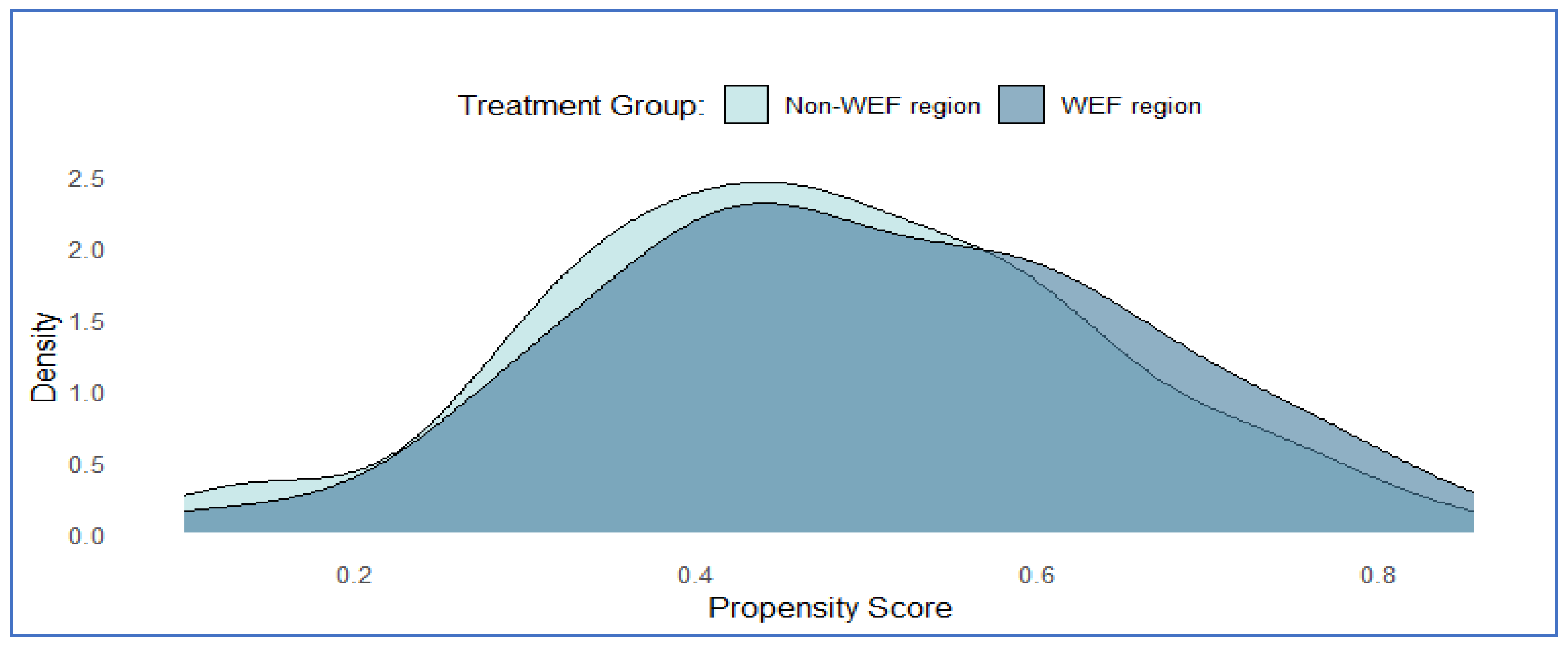
| Variable | Definition | Mean (Std. Dev.) | VIF |
|---|---|---|---|
| Dependent variables | |||
| Income | Annual income (Turkish Lira, TL) generated from hive production/1000 | 278.123 (257.228) | - |
| Explanatory variables: | |||
| Dummy variables: | |||
| Izmir | 1 if the beekeeper has produced honey in Izmir; 0 otherwise | 0.167 (0.373) | 2.273 |
| Aydin | 1 if the beekeeper has produced honey in Aydin; 0 otherwise | 0.167 (0.373) | 2.149 |
| Mugla | 1 if the beekeeper has produced honey in Mugla; 0 otherwise | 0.167 (0.373) | 2.664 |
| Manisa | 1 if the beekeeper has produced honey in Manisa; 0 otherwise | 0.167 (0.373) | 2.291 |
| Balikesir | 1 if the beekeeper has produced honey in Balikesir; 0 otherwise | 0.167 (0.373) | 1.857 |
| Canakkale | 1 if the beekeeper has produced honey in Canakkale; 0 otherwise (reference group) | 0.167 (0.373) | - |
| Age Cohort < 1965 | 1 if the beekeeper was born prior to 1965; 0 otherwise (reference group) | 0.317 (0.466) | - |
| Age Cohort 1965–1980 | 1 if the beekeeper was born between 1965 and 1980; 0 otherwise | 0.623 (0.485) | 1.377 |
| Age Cohort > 1980 | 1 if the beekeeper was born after 1980; 0 otherwise | 0.060 (0.238) | 1.596 |
| Elementary school | 1 if the beekeeper has no formal education or attained primary education; 0 otherwise (reference group) | 0.513 (0.501) | - |
| Secondary school | 1 if the beekeeper is a secondary school graduate; 0 otherwise | 0.127 (0.333) | 1.273 |
| High school | 1 if the beekeeper is a high school graduate; 0 otherwise | 0.197 (0.398) | 1.401 |
| College | 1 if the beekeeper is a university graduate, including master’s and doctoral degrees; 0 otherwise | 0.163 (0.370) | 1.589 |
| Widow/divorced | 1 if the beekeeper is widowed or divorced; 0 otherwise (reference group) | - | |
| Married | 1 if the beekeeper is married; 0 otherwise | 0.913 (0.282) | 2.296 |
| Never Married | 1 if the beekeeper has never been married; 0 otherwise | 0.047 (0.211) | 2.482 |
| Learning by others | 1 if beekeeping is learned by other means; 0 otherwise (reference group) | 0.240 (0.428) | - |
| Learning by father | 1 if beekeeping was inherited from the father; 0 otherwise | 0.490 (0.501) | 2.040 |
| Learning by courses | 1 if learned through beekeeping courses; 0 otherwise | 0.270 (0.445) | 1.729 |
| Car | 1 if the beekeeper has a vehicle; 0 otherwise | 0.830 (0.376) | 1.157 |
| Beekeeping registration | 1 if the business has a Beekeeping Registration System; 0 otherwise | 0.223 (0.417) | 1.202 |
| Farmer registration | 1 if the business has a Farmer Registration System; 0 otherwise | 0.417 (0.494) | 1.562 |
| Cooperative member | 1 if the operator is a member of a cooperative/union related to beekeeping; 0 otherwise | 0.943 (0.232) | 1.196 |
| Out of beekeeping job | 1 if the operator has an activity other than beekeeping; 0 otherwise | 0.777 (0.417) | 1.606 |
| Crop and animal production | 1 if the business has crop and animal production other than beekeeping; 0 otherwise | 0.493 (0.501) | 1.827 |
| Nomad | 1 if the beekeeper is nomadic; 0 otherwise | 0.853 (0.354) | 1.415 |
| Insurance | 1 if there is bee insurance; 0 otherwise | 0.430 (0.496) | 1.830 |
| Credit-based debt | 1 if agricultural loan; 0 otherwise | 0.377 (0.485) | 2.380 |
| Other bee production | 1 if other bee products are produced alongside honey production; 0 otherwise | 0.857 (0.351) | 1.208 |
| Credit use | 1 if the beekeeper has used agricultural credit during the year; 0 otherwise | 0.430 (0.496) | 2.775 |
| Livelihood | 1 if beekeeping is the main source of livelihood; 0 otherwise | 0.480 (0.500) | 2.176 |
| Wind energy farm region | 1 if the beekeeper is located in the wind energy farms area; 0 otherwise | 0.500 (0.501) | - |
| Continuous variables: | |||
| Road distance | Distance of the hive location to the main road (km) | 2.910 (2.132) | 1.134 |
| Experience proportion | Experience rate of beekeepers by age | 0.393 (0.191) | 1.546 |
| Working proportion | The ratio of the number of working persons in the family to the total family size | 0.452 (0.369) | 1.139 |
| Subsidy amount | Amount of state support for beekeeping activities throughout the year (TL/10,000) | 6.971 (4.842) | 2.192 |
| Body mass index | The beekeeper’s body mass index (weight divided by height squared) | 26.710 (3.436) | 1.185 |
| Number of observations | 300 | ||
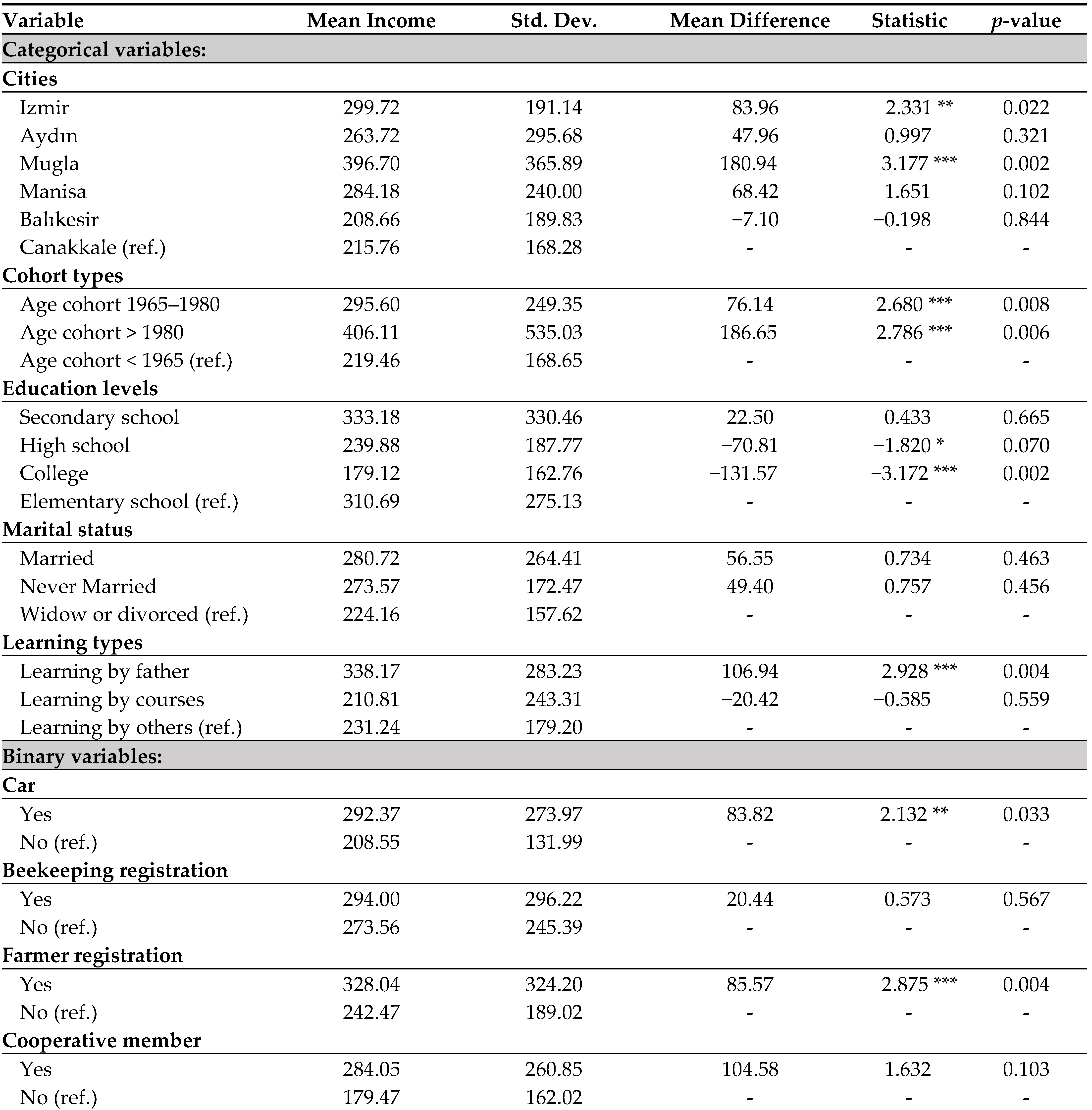 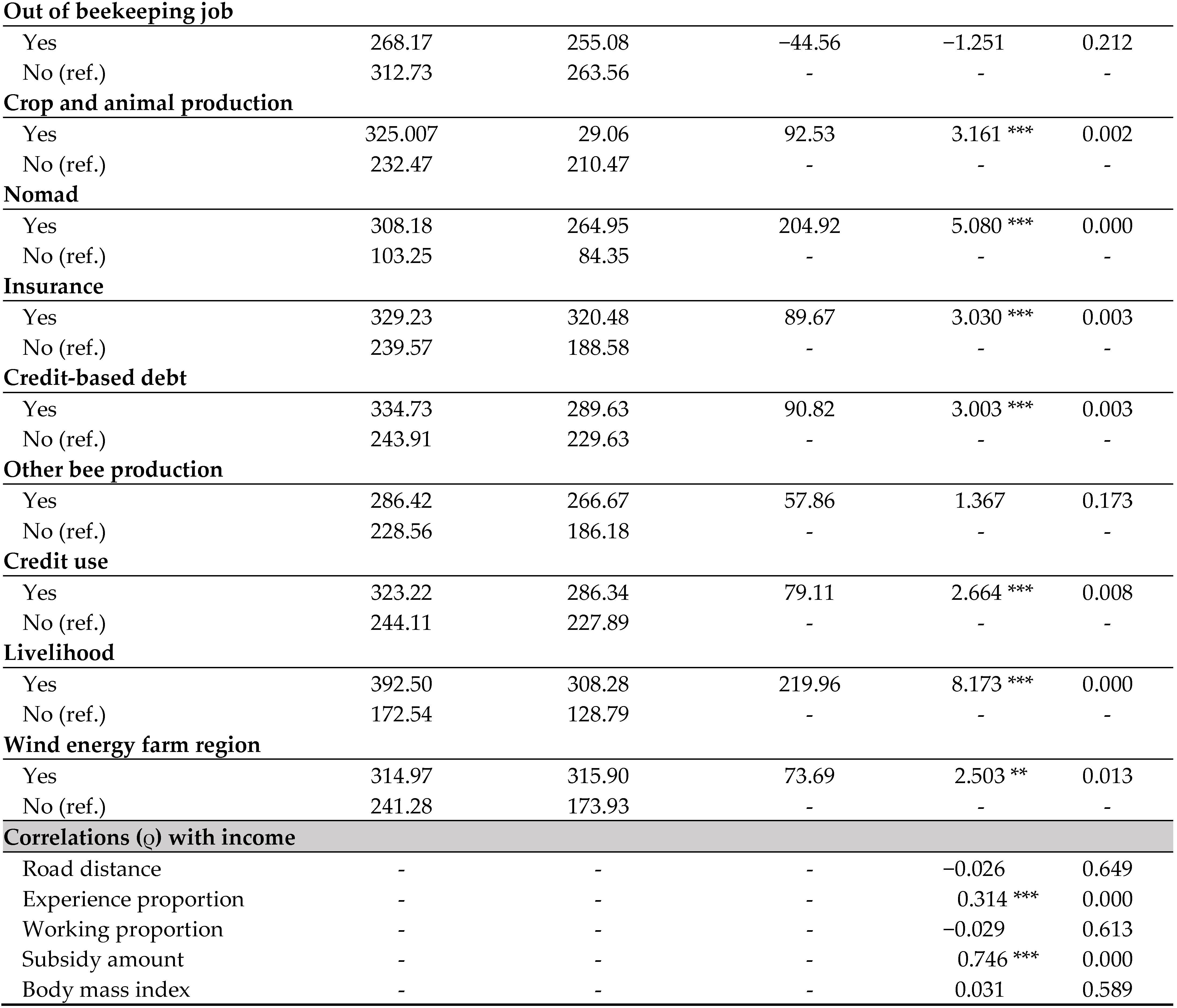 |
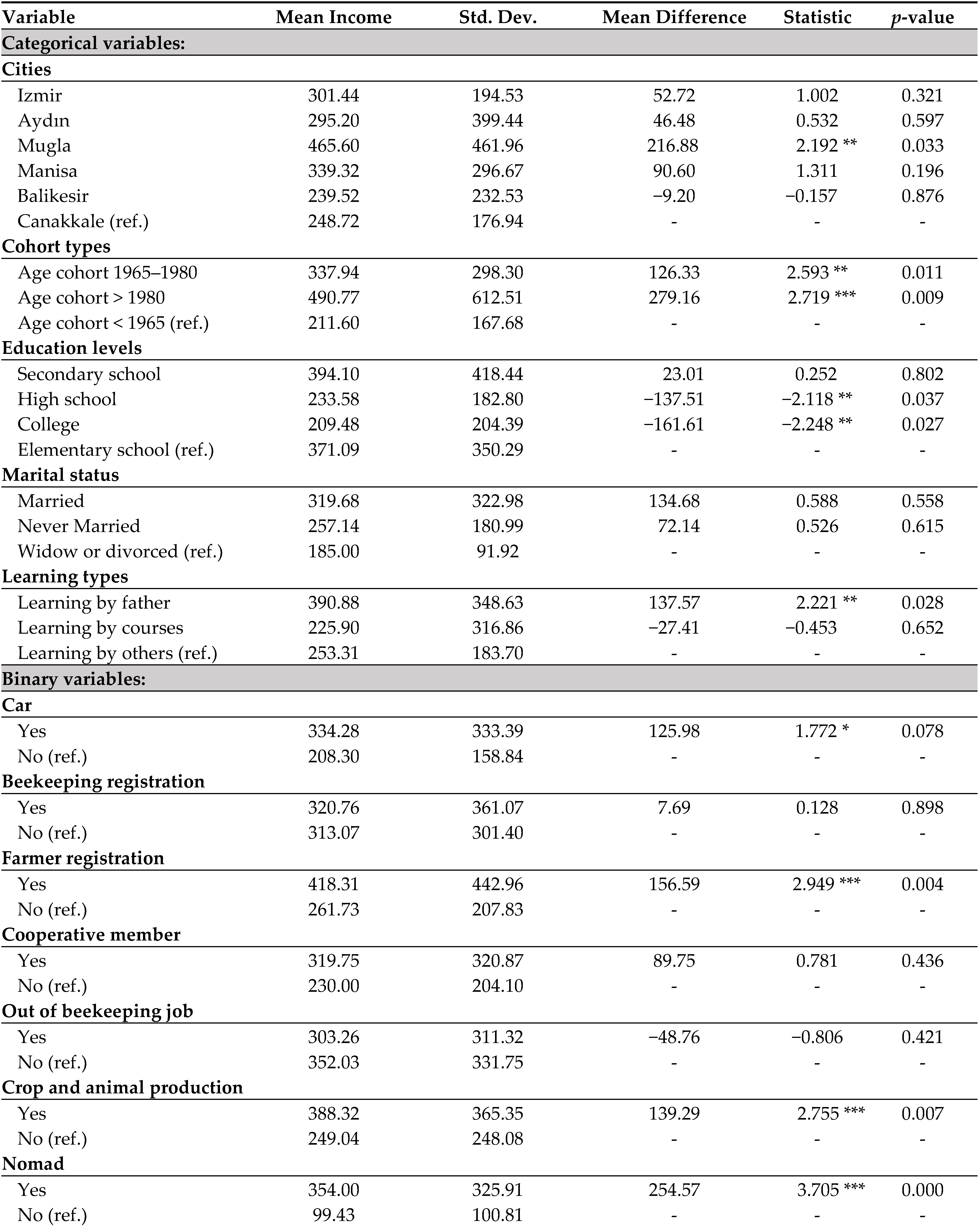 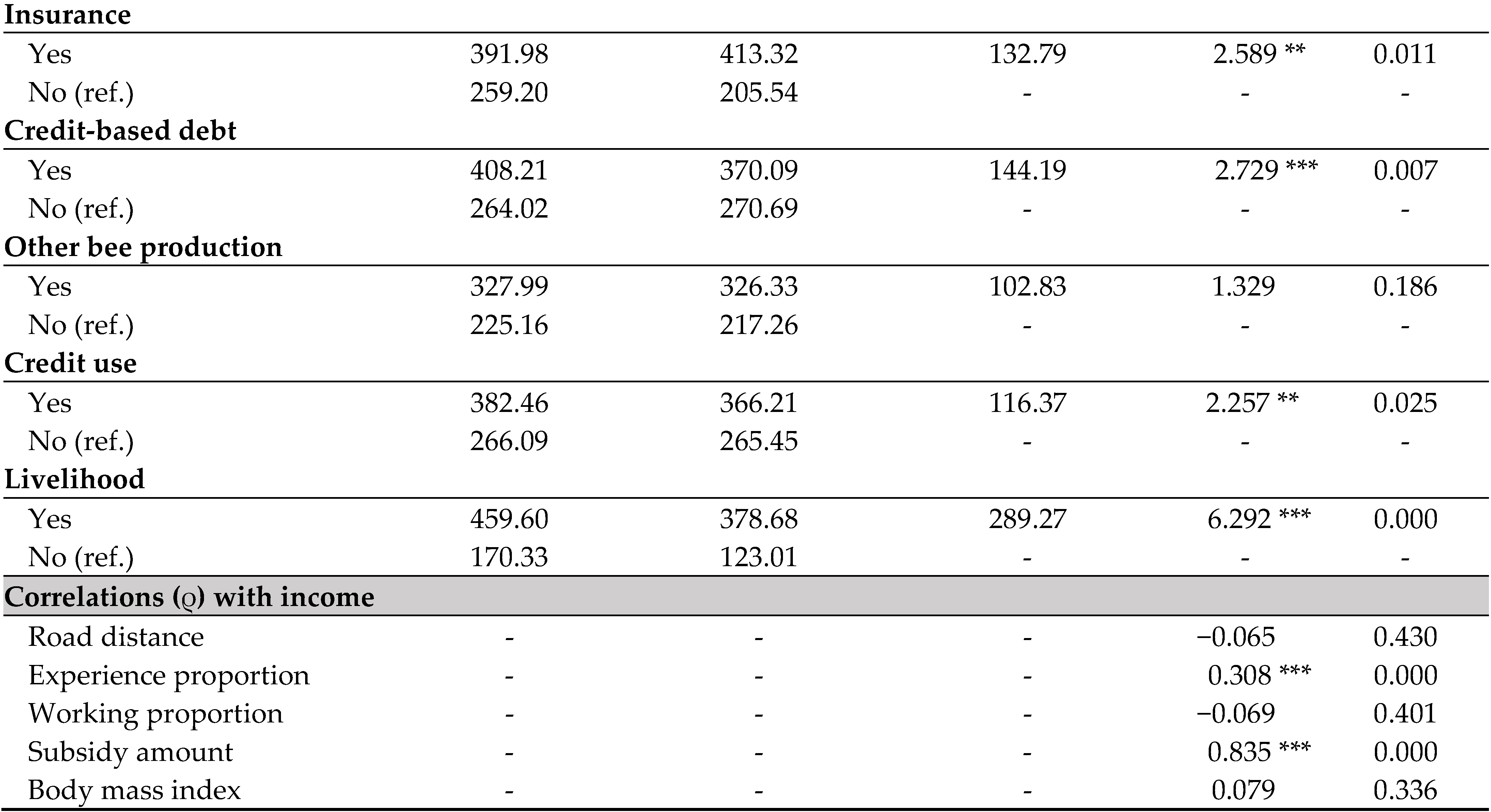 |
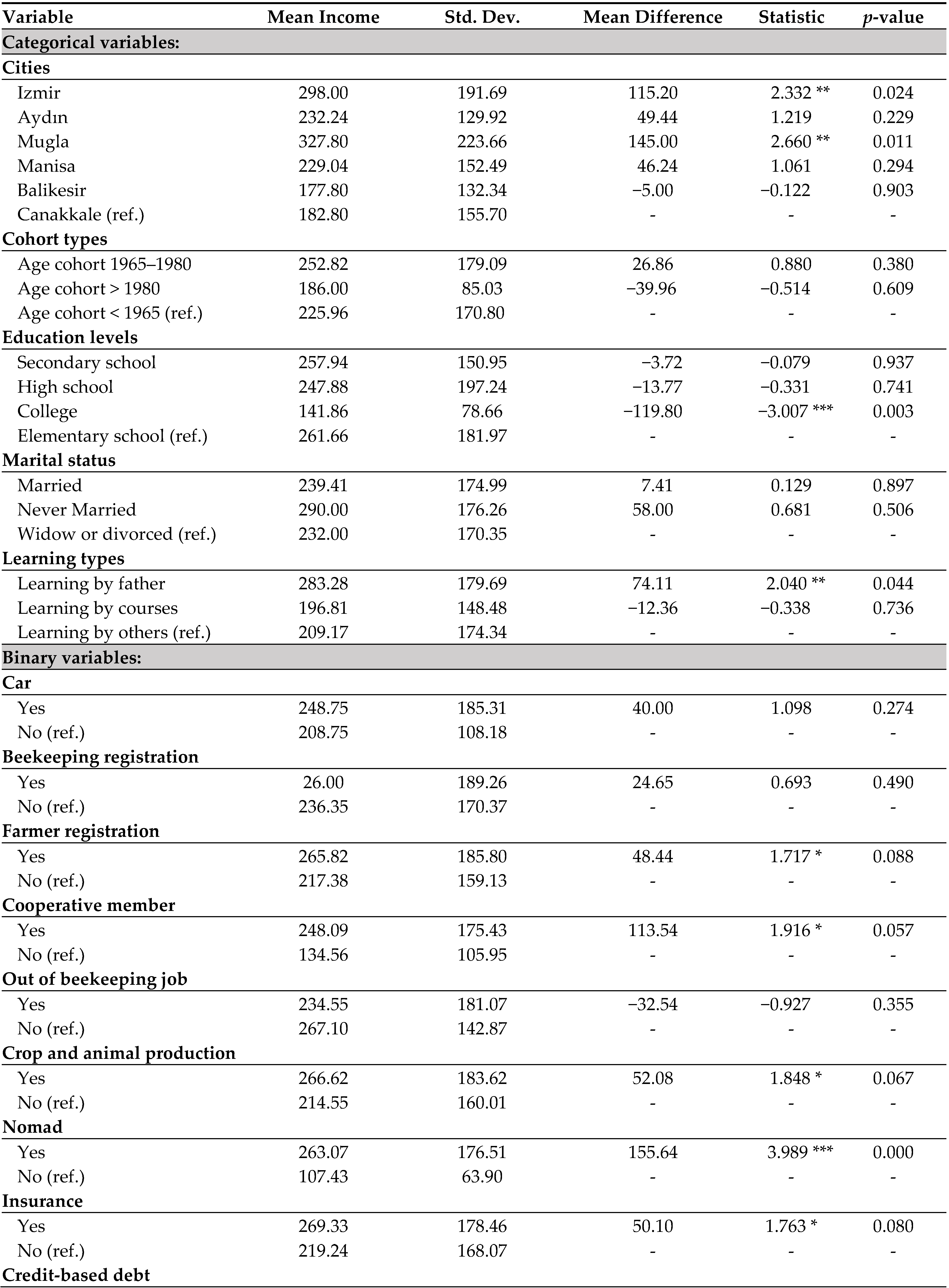 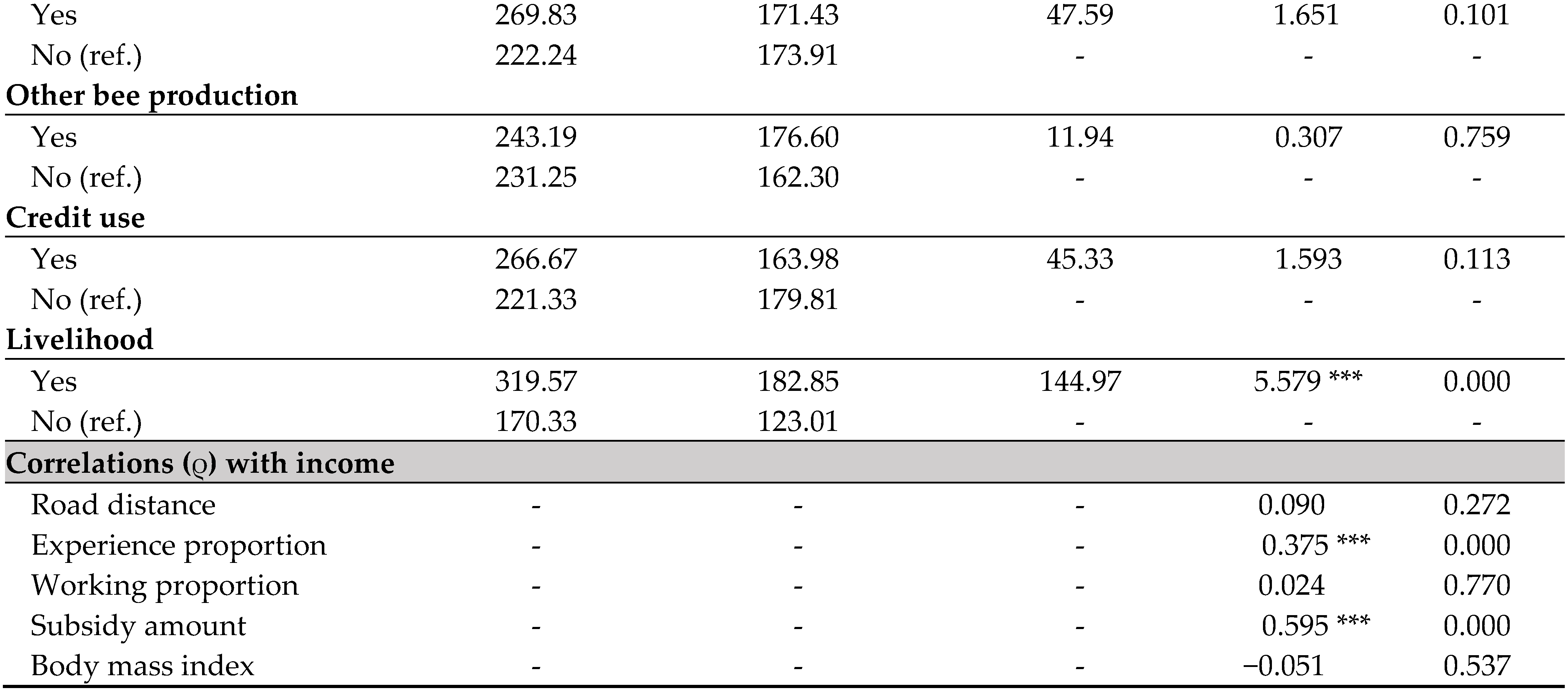 |
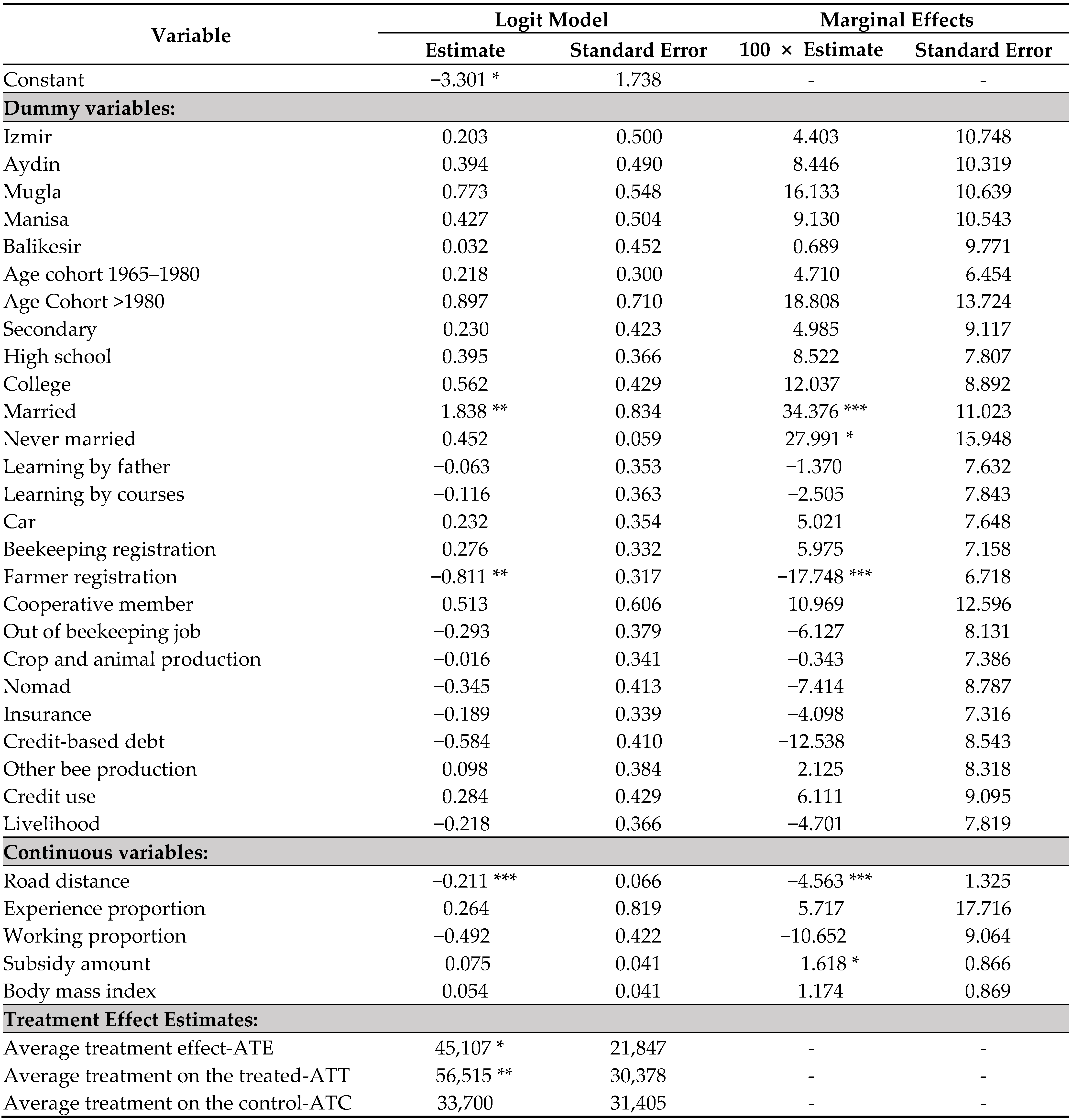 |
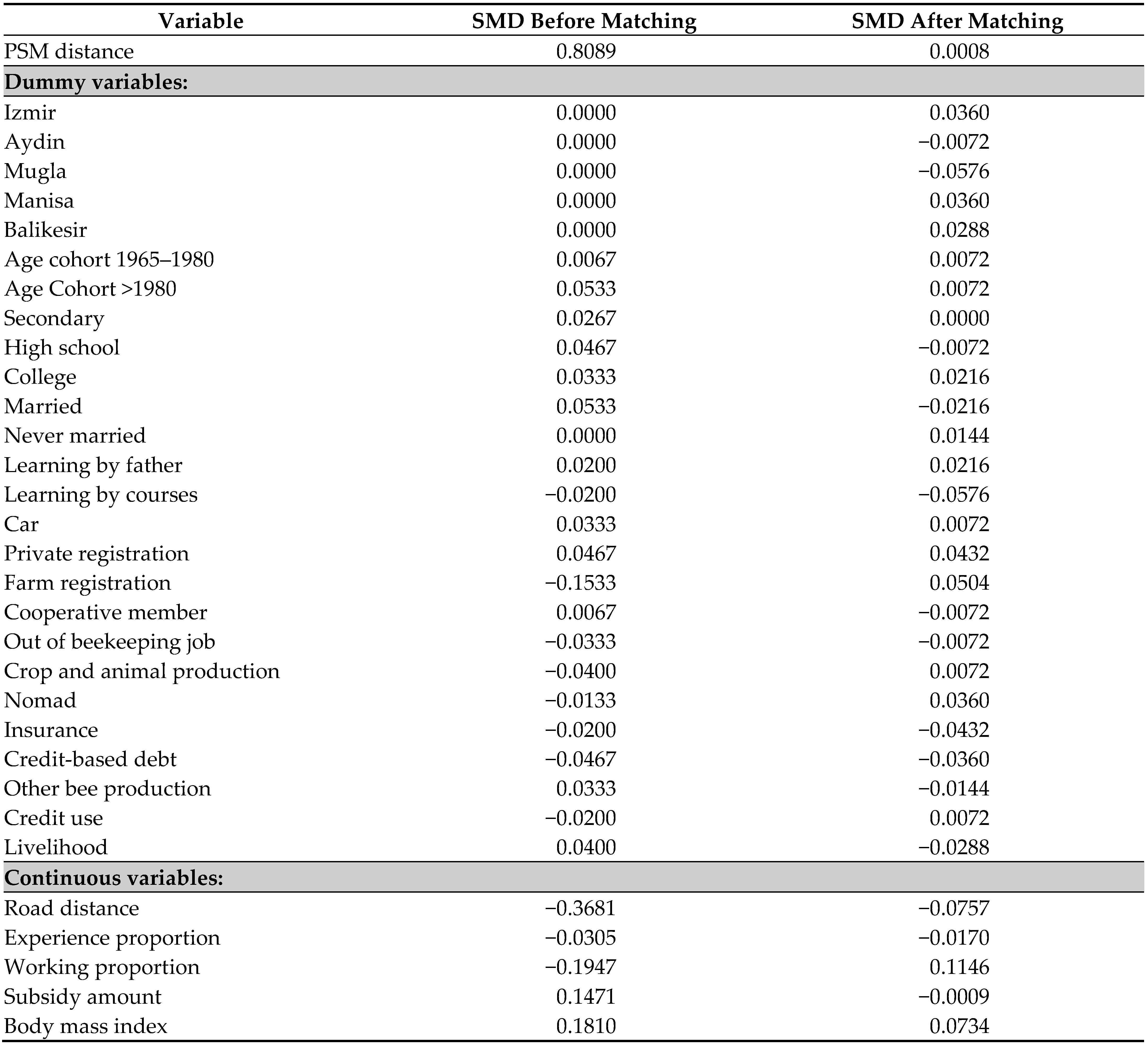 |
Disclaimer/Publisher’s Note: The statements, opinions and data contained in all publications are solely those of the individual author(s) and contributor(s) and not of MDPI and/or the editor(s). MDPI and/or the editor(s) disclaim responsibility for any injury to people or property resulting from any ideas, methods, instructions or products referred to in the content. |
© 2025 by the authors. Licensee MDPI, Basel, Switzerland. This article is an open access article distributed under the terms and conditions of the Creative Commons Attribution (CC BY) license (https://creativecommons.org/licenses/by/4.0/).
Share and Cite
Yıldız, M.S.; Demir, N.; Bilgic, A.; Aksoy, A.; Keskin, Ş. Sustainable Coexistence: Wind Energy Development and Beekeeping Prosperity—A Propensity Score Matching Approach. Energies 2025, 18, 4263. https://doi.org/10.3390/en18164263
Yıldız MS, Demir N, Bilgic A, Aksoy A, Keskin Ş. Sustainable Coexistence: Wind Energy Development and Beekeeping Prosperity—A Propensity Score Matching Approach. Energies. 2025; 18(16):4263. https://doi.org/10.3390/en18164263
Chicago/Turabian StyleYıldız, Mehmet Selim, Nuray Demir, Abdulbaki Bilgic, Adem Aksoy, and Şaban Keskin. 2025. "Sustainable Coexistence: Wind Energy Development and Beekeeping Prosperity—A Propensity Score Matching Approach" Energies 18, no. 16: 4263. https://doi.org/10.3390/en18164263
APA StyleYıldız, M. S., Demir, N., Bilgic, A., Aksoy, A., & Keskin, Ş. (2025). Sustainable Coexistence: Wind Energy Development and Beekeeping Prosperity—A Propensity Score Matching Approach. Energies, 18(16), 4263. https://doi.org/10.3390/en18164263







